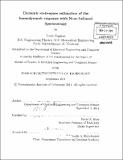| dc.contributor.advisor | David A. Boas. | en_US |
| dc.contributor.author | Gagnon, Louis, 1984- | en_US |
| dc.contributor.other | Massachusetts Institute of Technology. Dept. of Electrical Engineering and Computer Science. | en_US |
| dc.date.accessioned | 2012-01-12T19:32:34Z | |
| dc.date.available | 2012-01-12T19:32:34Z | |
| dc.date.copyright | 2011 | en_US |
| dc.date.issued | 2011 | en_US |
| dc.identifier.uri | http://hdl.handle.net/1721.1/68499 | |
| dc.description | Thesis (S.M.)--Massachusetts Institute of Technology, Dept. of Electrical Engineering and Computer Science, 2011. | en_US |
| dc.description | Cataloged from PDF version of thesis. | en_US |
| dc.description | Includes bibliographical references (p. 68-74). | en_US |
| dc.description.abstract | Near-Infrared Spectroscopy (NIRS) allows the recovery of the hemodynamic response associated with evoked brain activity. The signal is contaminated with systemic physiological interference which occurs in the superficial layers of the head as well as in the brain tissue. The back-reflection geometry of the measurement makes the DOI signal strongly contaminated by systemic interference occurring in the superficial layers. A recent development has been the use of signals from small source-detector separation (1 cm) optodes as regressors. Since those additional measurements are mainly sensitive to superficial layers in adult humans, they help in removing the systemic interference present in longer separation measurements (3 cm). Encouraged by those findings, we developed a dynamic estimation procedure to remove global interference using small optode separations and to estimate simultaneously the hemodynamic response. The algorithm was tested by recovering a simulated synthetic hemodynamic response added over baseline DOI data acquired from 6 human subjects at rest. The performance of the algorithm was quantified by the Pearson R2 coefficient and the mean square error (MSE) between the recovered and the simulated hemodynamic responses. Our dynamic estimator was also compared with a static estimator and the traditional adaptive filtering method. We observed a significant improvement (two-tailed paired t-test, p < 0.05) in both HbO and HbR recovery using our Kalman filter dynamic estimator compared to the traditional adaptive filter, the static estimator and the standard GLM technique. We then show that the systemic interference occurring in the superficial layers of the human head is inhomogeneous across the surface of the scalp. As a result, the improvement obtained by using a short separation optode decreases as the relative distance between the short and the long measurement is increased. NIRS data was acquired on 6 human subjects both at rest and during a motor task consisting of finger tapping. The effect of distance between the short and the long channel was first quantified by recovering a synthetic hemodynamic response added over the resting-state data. The effect was also observed in the functional data collected during the finger tapping task. Together, these results suggest that the short separation measurement must be located as close as 1.5 cm from the standard NIRS channel in order to provide an improvement which is of practical use. In this case, the improvement in Contrast-to-Noise Ratio (CNR) compared to a standard GLM procedure without using any small separation optode reached 50% for HbO and 100% for HbR. Using small separations located farther than 2 cm away resulted in mild or negligible improvements only. | en_US |
| dc.description.statementofresponsibility | by Louis Gagnon. | en_US |
| dc.format.extent | 74 p. | en_US |
| dc.language.iso | eng | en_US |
| dc.publisher | Massachusetts Institute of Technology | en_US |
| dc.rights | M.I.T. theses are protected by
copyright. They may be viewed from this source for any purpose, but
reproduction or distribution in any format is prohibited without written
permission. See provided URL for inquiries about permission. | en_US |
| dc.rights.uri | http://dspace.mit.edu/handle/1721.1/7582 | en_US |
| dc.subject | Electrical Engineering and Computer Science. | en_US |
| dc.title | Dynamic state-space estimation of the hemodynamic response with Near-Infrared Spectroscopy | en_US |
| dc.type | Thesis | en_US |
| dc.description.degree | S.M. | en_US |
| dc.contributor.department | Massachusetts Institute of Technology. Department of Electrical Engineering and Computer Science | |
| dc.identifier.oclc | 770669080 | en_US |
